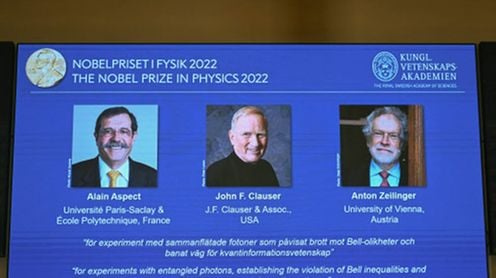The Royal Swedish Academy of Sciences announced on October 4, 2022 that Alain Aspect, John F. Clauser, and Anton Zeilinger will receive the Nobel Prize in Physics in 2022 for their work on quantum mechanics.
The 2022 Nobel Prize in Physics has been awarded “for experiments with entangled photons, establishing the violation of Bell inequalities, and pioneering quantum information science,” the academy said.
The development of experimental tools by the 2022 physics laureates has laid the groundwork for a new era of quantum technology. The ability to manipulate and manage quantum states and all of their layers of properties provides us with unexpected tools.
Intense research and development is being conducted to exploit the unique properties of individual particle systems in order to build quantum computers, improve measurements, build quantum networks, and establish secure quantum encrypted communication.
John Clauser, this year’s Nobel laureate, created an apparatus that emitted two entangled photons at a time, each towards a filter that tested their polarisation. The result was a clear violation of a Bell inequality that agreed with quantum mechanics predictions.
Alain Aspect, who was awarded the Nobel Prize in Physics in 2022, devised a method to plug a critical gap. He was able to change the measurement settings after an entangled pair had left its source, ensuring that the setting in place when they were emitted had no effect on the outcome.
Anton Zeilinger, the 2022 Nobel Prize in Physics winner, studied entangled quantum states. His research group has demonstrated quantum teleportation, which allows a quantum state to be transferred from one particle to another over a long distance.
The physics Nobel laureates for 2022 have carried out ground-breaking experiments using entangled quantum states, in which two particles behave like a single unit even when separated. upThe findings have paved the way for new technology based on quantum information.
The development of experimental tools by the 2022 physics laureates has laid the groundwork for a new era of quantum technology. The ability to manipulate and manage quantum states and all of their layers of properties provides us with tools with unexpected potential, according to the accademy.
The special properties of individual particle systems are being used to build quantum computers, improve measurements, build quantum networks, and establish secure quantum encrypted communication, according to the report.
One of the prize winners, Anton Zeilinger, stated, “I’m still very shocked, but it’s a very positive shock.” I was surprised to receive the call just an hour ago.”
His research has demonstrated a phenomenon known as quantum teleportation, which allows a quantum state to be transferred from one particle to another over a long distance.
He described quantum teleportation as using the properties of entanglement to transport information carried by the object to another location where the object is then reconstituted. This can be done without knowing the information because knowing the information would violate Heisenberg’s uncertainty principle, which states that an object’s position and momentum cannot both be measured exactly, at the same time, even in theory.
“So far this can be done on very small particles. It is fundamentally important for transferring information between quantum computer,” he said.
The physics prize is announced on Tuesday, followed by the chemistry prize on Wednesday, and the literature and peace prizes are announced on Thursday and Friday, respectively.
Svante Paabo, a Swedish paleogeneticist who sequenced the Neanderthal genome and discovered the previously unknown hominin Denisova, was awarded the Nobel Prize in Medicine on Monday.
Source:TH







 Finance
Finance







